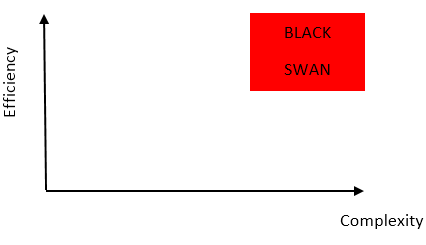Application of Antifragility in Project Management
Lassehoier87 (Talk | contribs) |
Lassehoier87 (Talk | contribs) |
||
| Line 19: | Line 19: | ||
| − | + | ||
| + | |||
| + | |||
| + | |||
| + | |||
| + | |||
| + | |||
== Create Project Portfolios that can Collectively Learn from Others’ Mistakes == | == Create Project Portfolios that can Collectively Learn from Others’ Mistakes == | ||
Revision as of 12:06, 21 September 2015
“To see how large things can be fragile, consider the difference between an elephant and a mouse: The former breaks a leg at the slightest fall, while the latter is unharmed by a drop several multiples of its height. This explains why we have so many mice than elephants”
Organizations established on the idea that any volatility is poison to the system, is not in balance with the laws of nature. Such organizations is fragile and will properly suffer from times with high volatility. Exposed to high volatility has the ability to show vulnerability or weakness of an organization. As the immune systems thrives with viruses in order to keep being intact, the antifragility organization thrives with volatility in order to improve and grow. In this sense, nature gives the answer to high volatility in organizations.
The projects of our time are designed for stability and can be defined as highly complex, pursuit of effectivity and interdependency.
In order understand this; imagine how a project would look like in the past century. The projects were less complex, simply because projects had a lower technical level. Things such as the globalization also add to the complexity. While the parts for a building usually was build or assembled nearby in the past, things are usually shipped to the construction site from the other side of the world today. A lot of the processing of high complexity within an organization is divided into the various academic disciplines. This can be a great challenge to the project management and demands a high level of communication from each discipline. In order for the project manager to make the best planning, risk analysis etc., the complexity has to have more focus in the project management. High complexity has the tendency of surprising, because no one “saw it coming”.
Second, the efficiency is a huge driver to failure in projects. In the pursuit of efficiency, fewer and fewer things are controlling more and more.
“The stock exchanges have converted from “open outcry” where wild traders face each other, yelling and screaming as in a souk, then go drink together. Traders were replaced by computers, for very small visible benefits and massively large risks. While errors made by traders are confined and distributed those made by computerized systems go wild”
For the past 2-3 decades, we have continued the pursuit of efficiency, but the risk is neglected. In projects were communication between each discipline is a key word, the high computerization can be a big challenge to handle. Within this computerization lies a high risk to the project schedule. This argues for more understanding of the computer systems in order to reduce the complexity. The term “Black Swan” defines a rare and unpredictable event, highly difficult to prepare for. “Black Swan” is a typical phenomenon in a fragile system. What we should do, is build a system that is not fragile to these events.
Thirdly, interdependency is the indispensable link between “efficiency” and “complexity”. The interdependency is a never-ending story, always seeking to be more efficient and thereby more complex. For the project to be successful, the project manager most learn to deal with an increasing level of complexity. The ability to identify areas of high complexity within the project is of great importance in future project management.
